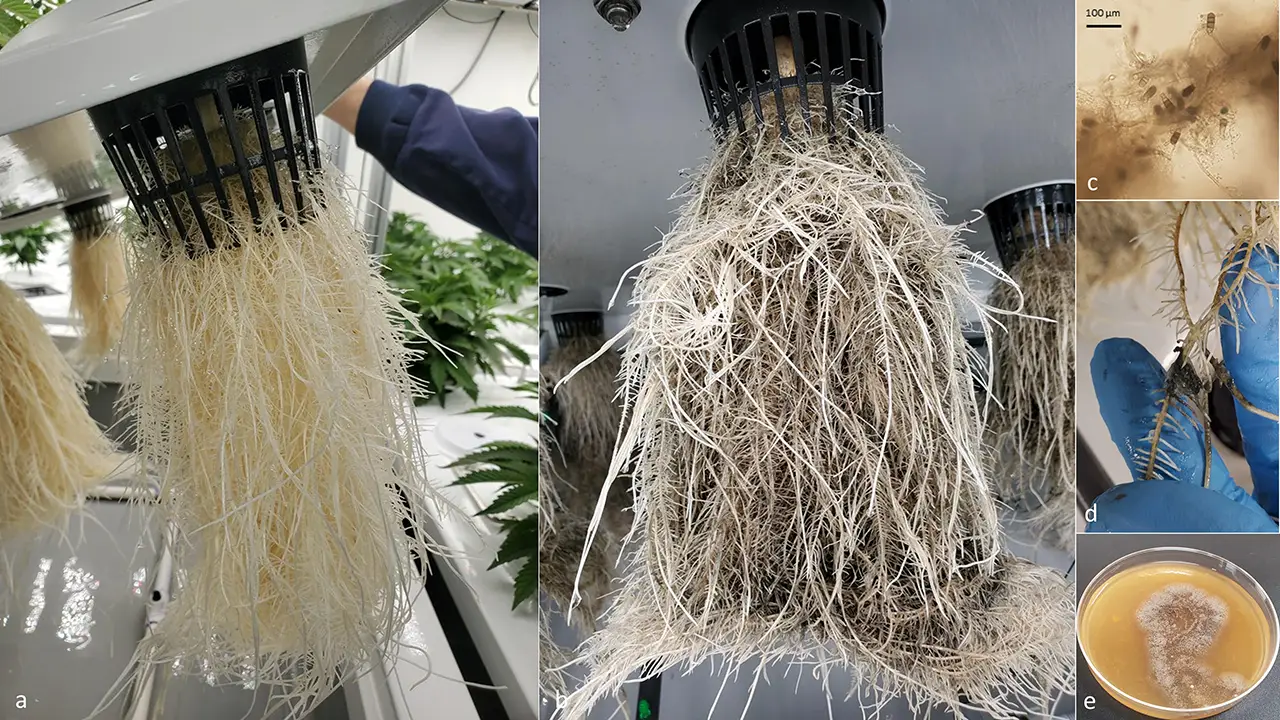The fungus that causes the plant disease black root rot has spread to cannabis plants beyond hemp, warns new research that identified the pathogen in a licensed commercial cultivation facility in British Columbia, Canada.
Black root rot can be fatal to cannabis plants, said Chris Dumigan, a Ph.D. candidate in biology at the University of British Columbia Okanagan who specializes in cannabis and is lead author of the new research in the academic journal Plant Disease.
“It’s growing on and inside your root tissue and then it’s causing the roots to die, and the plant will eventually die as a consequence of that,” Dumigan told MJBizDaily.
The affected marijuana facility in Cranbrook, B.C., “had to throw out a whole bunch of equipment, they had to get rid of a bunch of plants, because they had a fungus that was growing and taking hold of their facility,” he added.
“And if you can’t control that, you’ll face total crop destruction.”
Black root rot was previously documented in a hemp greenhouse in Kentucky in late 2019, according to a 2022 paper in the same journal.
The research marks the first report of “black root rot in high THC-containing cannabis,” the new paper notes.
Confirmation of black root rot in marijuana comes as the industry focuses on plant pathogens in light of the spreading impact of hop latent viroid.
However, David Kessler, chief science officer with Billerica, Massachusetts-based marijuana cultivation technology Agrify Corp., said he doesn’t expect black root rot will pose the same economic threat to the cannabis industry as does hop latent viroid.
“That said, those cultivators that are affected by this most certainly are going to feel that economic damage, but having it be pervasive through the industry is less likely,” said Kessler, who was not involved in the research.
‘More widespread than people think’
Commercial marijuana businesses should be aware that black root rot exists and poses “a threat to their bottom line,” cannabis researcher Dumigan said.
The B.C. outbreak occurred at a cultivation facility that uses aeroponics, a method that leaves plant roots exposed and feeds them with a mist of water and nutrients.
The grower contacted Dumigan after sending diseased plants for pathogen testing and receiving negative results.
“To me, it’s nothing to be ashamed of, because that facility is quite clean,” he said.
“It’s not an oversight on their part, they were more or less a victim of a lack of research in the area,” Dumigan continued.
“This thing is more widespread than people think.”
In Australia, the destructive effect of black root rot on cotton crops has led to it being declared a pandemic, according to the paper.
Cannabis hasn’t been subjected to “the same research as other crops of similar market value,” Dumigan said.
“So something like this can fly under the radar and still be discovered as a new pathogen in this crop in 2022, which I think is very interesting – but also points to a lack of knowledge about cannabis, cannabis cultivation and cannabis pathology.”
Considering that black root rot has also been documented in greenhouse-grown hemp on the opposite side of North America, Dumigan said he would be “highly surprised” if the disease was new to marijuana.
Infections might have been misclassified as another kind of root rot, he said.
Aeroponic question unanswered
It’s not surprising that black root rot would affect cannabis, said Kessler, Agrify’s chief science officer.
“It thrives in cool and wet conditions,” he explained.
In particular, Kessler suspects black root rot might be more likely in an aeroponic environment such as the B.C. facility where it was detected, as opposed to cannabis grown in a medium.
Aeroponic growing is not the typical method of commercial cannabis production.
It involves “a very humid, air-rich environment, and that is a really great place to grow fungus,” Kessler said.
Without the buffer of a growing medium, he added, cannabis can be subject to “much more rapid temperature swings.”
“And that can be something that helps promote these types of diseases,” he said.
“A lot of these fungal spores can survive significant amounts of time just waiting for the right host and environment before they will – if you will – sprout and replicate.”
University of British Columbia Okanagan researcher Dumigan said the B.C. aeroponic facility in question grew “really robust cannabis plants that were disease-free for the longest time” using a pathogen control method.
“I do wonder whether it’s this unique (aeroponic) environment that really allowed this fungus to take hold in this facility,” Dumigan said.
Despite that theory, Dumigan cautioned that the research does not prove any link between black root rot and aeroponic cannabis cultivation.
“Since (the aeroponic facility has) been able to deal with this pathogen – monitoring it closely, always watching the roots – they haven’t had any issues and they have really good healthy crops,” he said.
More research needed
Dumigan and his colleagues isolated the black root rot sample from the Canadian facility into a culture and sequenced its genome for the first time, allowing them to further study the fungus.
“But what’s really interesting (is), we can start to develop diagnostic tests that use (genome) sequence information to determine when it is there and when it is not,” Dumigan told MJBizDaily.
Dumigan said he’s interested in developing new tests to detect the presence of black root rot in wastewater.
Early detection is “imperative,” he said.
“Because if you don’t detect it early, you can’t quarantine the infected crops, and it’s just going to spread through your facility.”
In the meantime, Dumigan has shared a technical bulletin about black root rot in cannabis on LinkedIn.
He said more research on black root rot in cannabis could include researching ways to combat the threat, such as microorganisms that produce antifungal compounds.
Anecdotally speaking, Dumigan said, “we’ve seen genotype-specific resistance to this and that some cultivars of cannabis will show more resistance than others.”
Solomon Israel can be reached at solomon.israel@mjbizdaily.com.





